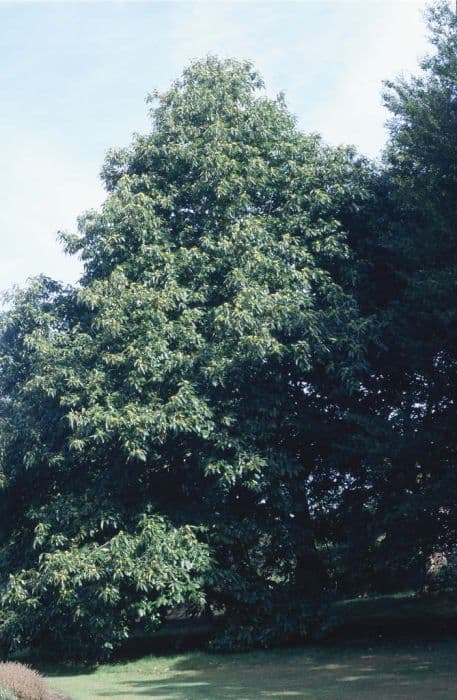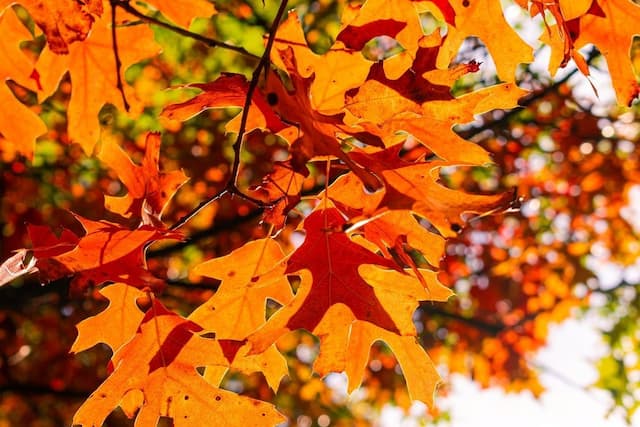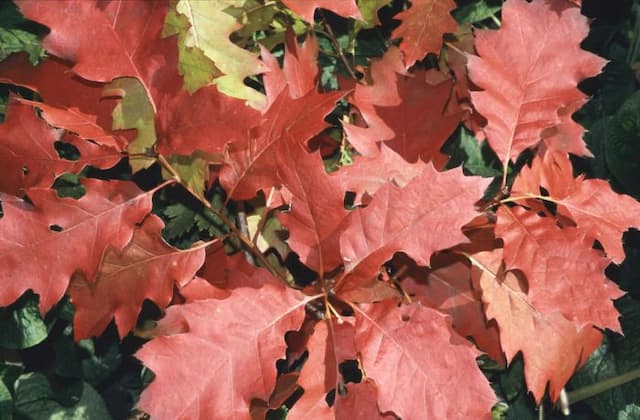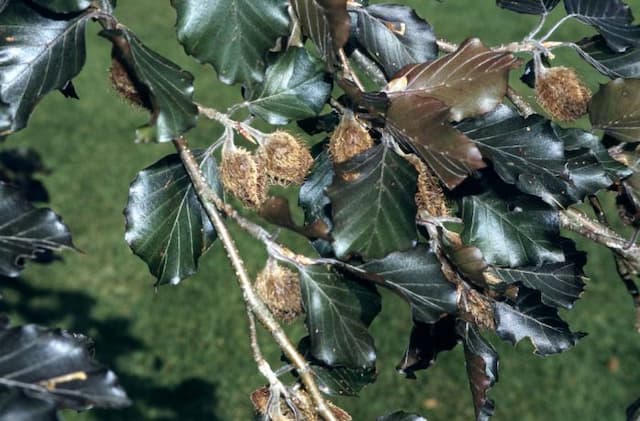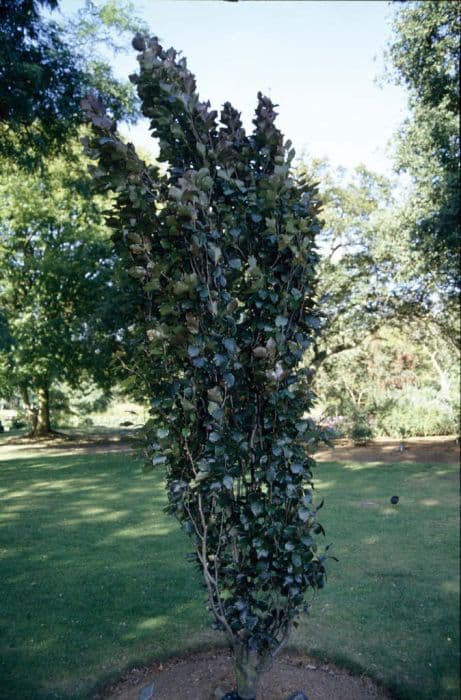Sessile Oak Quercus petraea

ABOUT
The plant commonly known as sessile oak is recognized for its robust trunk and widespread branches that create a large, rounded canopy. Its bark is grey and deeply fissured, providing a coarse texture. The leaves are distinctive, with their wavy edges and deep lobes; they typically showcase a bright green hue on the upper surface and a paler tone underneath. During the spring, the sessile oak displays long, yellowish-green catkins which hang amidst the foliage, adding a touch of color before the leaves fully emerge. Eventually, the tree bears fruit in the form of acorns, noteworthy because they lack stems (or stalks) and sit directly on the twigs, unlike those of other oaks that usually have a stem. In the fall, the leaves transition to a rich array of colors, often turning shades of gold, russet, or brown before they drop to the ground, creating a seasonal carpet beneath the tree's extensive boughs. This annual transformation provides not only a visual treat but also contributes to the ecosystem by offering habitat and nourishment to various wildlife species.
About this plant
 Names
NamesFamily
Fagaceae.
Synonyms
Sessile Oak, Durmast Oak, Irish Oak, Cornish Oak, Welsh Oak.
Common names
Quercus sessilis, Quercus lanuginosa, Quercus sessiliflora.
 Toxicity
ToxicityTo humans
The plant in question, Quercus petraea, commonly known as the sessile oak, is not generally considered toxic to humans. However, ingestion of large quantities of acorns or leaves, particularly by children, can lead to stomach upset and may result in symptoms such as nausea, vomiting, diarrhea, and abdominal pain due to the presence of tannic acid. While not commonly consumed or associated with severe toxicity in humans, it's advisable to avoid eating parts of this tree in significant amounts.
To pets
The sessile oak, Quercus petraea, can be toxic to pets if they ingest parts of the plant, especially acorns or leaves. The toxic principle is tannic acid, which can cause gastrointestinal issues such as vomiting and diarrhea. In severe cases, consumption of acorns can lead to kidney damage or even obstruction if large pieces are swallowed. While generally not fatal, it's important to prevent pets from consuming this plant to avoid potential health complications.
 Characteristics
CharacteristicsLife cycle
Perennials
Foliage type
Deciduous
Color of leaves
Green
Height
60 70 feet (18 21 meters)
Spread
60 70 feet (18 21 meters)
Plant type
Tree
Hardiness zones
5-8
Native area
Europe
Benefits
 General Benefits
General Benefits- Wildlife Habitat: Quercus petraea, commonly known as sessile oak, provides essential habitat for various wildlife species, offering them food in the form of acorns and shelter within its foliage and bark.
- Timber Production: The sessile oak is valued for its hard and durable wood, which is used in construction, furniture, and barrel-making industries.
- Erosion Control: With its extensive root system, the sessile oak helps stabilize soil, preventing erosion and promoting soil health in its natural forest environment.
- Carbon Sequestration: As a large, long-lived deciduous tree, sessile oak plays a significant role in capturing carbon dioxide from the atmosphere, thus helping to mitigate the effects of climate change.
- Recreational and Aesthetic Value: Quercus petraea enhances landscapes with its majestic form and contributes to the scenic beauty of forests, parks, and rural areas, offering recreational spaces for humans.
- Biodiversity Support: By providing food and microhabitats, sessile oak contributes to the biodiversity of an area, supporting various plant and animal species within its ecological community.
- Ecosystem Services: Sessile oak supports forest ecosystems by contributing to nutrient cycles through leaf and wood decay and offering pollination opportunities for certain insects.
- Historical and Cultural Significance: The sessile oak holds important cultural and historical value in various regions, often being associated with strength, endurance, and longevity in folklore and tradition.
- Climatic Adaptability: Quercus petraea is known for its adaptability to different climatic conditions, making it an important species for reforestation and forest resilience.
- Soil Improvement: The leaf litter from sessile oak decomposes to form humus, enriching the soil and promoting the growth of other plant species.
 Medical Properties
Medical Properties- Anti-inflammatory: Quercus petraea, also known as sessile oak, has been used traditionally to treat inflammation.
- Astringent: The bark contains tannins that can act as a natural astringent.
- Antiseptic: The tannins also have antiseptic properties useful in healing wounds.
- Antidiarrheal: The astringent qualities have been used to treat diarrhea by tightening the gut tissues.
- Vein tonic: It may strengthen blood vessels and improve vein health.
 Air-purifying Qualities
Air-purifying QualitiesThis plant is not specifically known for air purifying qualities.
 Other Uses
Other Uses- Tannin Extraction: Quercus petraea bark contains tannins, which can be used in the tanning of leather, transforming animal hides into durable leather.
- Woodworking: The wood of Quercus petraea, commonly known as Sessile oak, is valuable for cabinet making and intricate joinery due to its strength and attractive grain.
- Wine and Spirit Barrels: Sessile oak is used in cooperage for the production of wine and whiskey barrels where it contributes to the flavor development during aging.
- Flooring Material: The timber is durable and hard-wearing, making it an excellent choice for flooring in high traffic areas.
- Charcoal Production: The wood of Sessile oak can be carbonized to produce high-quality charcoal for artistic use and barbecuing.
- Shipbuilding: Historically, the strong timber of Quercus petraea was used in shipbuilding, particularly for the framework due to its resistance to water and rot.
- Venue Decoration: The branches and acorns of Sessile oak can be used for rustic and natural decorative elements in events and landscaping.
- Woodturning: Sessile oak is a favored material for woodturners, making bowls, vases, and other decorative items.
- Ink Production: Gallnuts from Quercus petraea trees, when combined with iron salts, produce a strong, permanent ink used historically for writing and drawing.
- Wildlife Habitat: The tree, including its leaves and acorns, provides food and habitat for various species of birds, insects, and mammals, supporting biodiversity.
Interesting Facts
 Feng Shui
Feng ShuiThe Oak tree is not used in Feng Shui practice.
 Zodiac Sign Compitability
Zodiac Sign CompitabilityThe Oak tree is not used in astrology practice.
 Plant Symbolism
Plant Symbolism- Strength: The Quercus petraea, commonly known as the Sessile Oak, has a hard and robust wood that symbolizes strength and durability. It is often associated with physical and moral fortitude.
- Wisdom: Throughout history, oaks have been regarded as wise due to their long lifespan and towering presence. They are considered symbols of knowledge and wisdom.
- Endurance: Sessile Oaks are known to withstand harsh conditions, representing the ability to endure and persist through challenging times.
- Nobility: In many cultures, the oak is seen as a noble tree, symbolizing honor, nobility, and the higher ideals of humanity.
- Heritage: As oaks are trees that can live for hundreds of years, they often represent heritage and are connected to the idea of passing on legacies through generations.
- Stability: The deep root system of the Sessile Oak provides exceptional stability, making it symbolic of a grounded character and reliable presence.
 Water
WaterSessile oak trees require moderate watering, especially when they are young and establishing their root systems. Once mature, they are quite drought-tolerant due to their deep root system. Water the tree with about 15-20 gallons once a week during dry spells without rainfall. Reduce the frequency of watering as the tree matures, allowing natural precipitation to suffice unless there are prolonged periods of dryness. It's essential to avoid over-watering as this can lead to root rot.
 Light
LightSessile oaks thrive in full sunlight, meaning they prefer a location where they can receive at least six hours of direct, unfiltered sunlight each day. They can tolerate partial shade, especially when young, but full sun exposure is ideal for robust growth and optimal health. Choose a planting spot that's away from taller structures or trees that might shade the oak as it grows.
 Temperature
TemperatureSessile oaks are hardy in a range of temperatures and can survive winter lows down to about -20°F. The optimal growing temperature range for a sessile oak is between 60°F and 80°F. Extreme heat above 95°F can stress the tree, especially during drought conditions, but it can tolerate such temperatures if adequately watered.
 Pruning
PruningPrune sessile oaks to remove dead or broken branches, to shape the tree during its formative years, and to remove any branches that pose a risk due to damage or disease. The best time for pruning is in the dormant season, usually late winter to early spring before new growth starts. Occasional thinning of the canopy can also be beneficial, allowing light and air to reach the interior of the tree. Pruning should be done every 2-3 years or as needed.
 Cleaning
CleaningAs needed
 Soil
SoilSessile oak (Quercus petraea) thrives in well-draining, loamy soil with a slightly acidic to neutral pH of 5.5 to 7. A mix of garden soil, compost, and sand or perlite can provide the necessary drainage and nutrients.
 Repotting
RepottingSessile oak, being a large tree, is not typically repotted. It's best grown outdoors with ample space for its extensive root system.
 Humidity & Misting
Humidity & MistingSessile oak is adaptable to a wide range of humidity levels found in outdoor environments and does not have specific humidity requirements.
 Suitable locations
Suitable locationsIndoor
Sessile oaks are not suitable for indoor growth due to size.
Outdoor
Plant in well-draining soil, full sun, and give space to grow.
Hardiness zone
5-8 USDA
 Life cycle
Life cycleThe life of the Sessile Oak (Quercus petraea) starts with acorn germination, which occurs in spring after overwintering on the forest floor. The acorn sprouts a taproot and shoot, developing into a seedling with lobed leaves characteristic of oaks. As the sessile oak grows, it transitions into a sapling phase, where the tree increases in girth and height, slowly maturing over several decades. After reaching maturity at around 40 years, the sessile oak begins to produce its own acorns, initiating the reproductive phase, which can continue for hundreds of years. Throughout its life, the sessile oak goes through seasonal changes, shedding leaves in the autumn and entering dormancy in the winter, then leafing out again in the spring. The sessile oak can live for many centuries, with some individuals reaching over 1000 years of age before eventually succumbing to old age or environmental disturbances.
 Propogation
PropogationPropogation time
Late winter to early spring
The most popular method of propagating the Sessile Oak, Quercus petraea, is through its acorns, which are its seeds. The best time for sowing acorns is in the fall, shortly after they have ripened and fallen from the tree. The acorns should be planted in a well-drained seedbed or directly in the spot where the tree is intended to grow, at a depth of approximately 1 to 2 inches (2.5 to 5 cm). It's essential to protect the planted acorns from predation by animals, which can be done by using a wire mesh or similar barrier. Once the acorns germinate in spring, the seedlings grow quickly, and with minimal care, they will establish themselves to eventually become mature oak trees.
